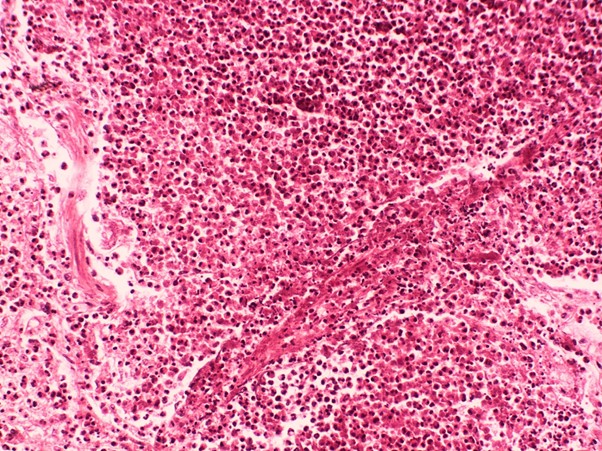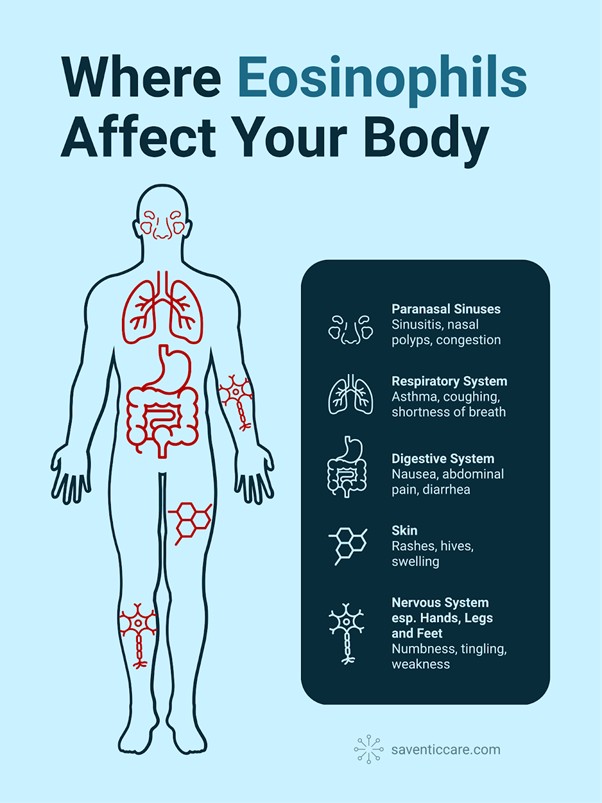Eosinophilia: What a High Eosinophil Count Could Mean
If you’ve recently been told you have eosinophilia, you’re not alone. Eosinophilia means you have an elevated level of eosinophils, a type of white blood cell involved in immune responses. While this can be harmless in some cases, it can also be a sign of something more serious, such as EGPA (eosinophilic granulomatosis with polyangiitis), a rare disease.
This article explains what eosinophilia is, what symptoms and causes are possible, and when it makes sense to seek further testing.
What Is Eosinophilia?
Eosinophils are immune cells that help your body react to allergens and fight certain infections, particularly parasites according to Kanuru & Sapra (2022). Normally, they are present in small numbers in your blood. When eosinophil levels rise above 500 cells per microliter — a state known as eosinophilia — it may signal that your immune system is overreacting or dealing with a hidden condition.
If your count goes beyond 1,500/μl, your doctor may recommend further evaluation, especially if symptoms are present.

What Does a High Eosinophil Count Mean?
A high eosinophil count means that your immune system is reacting to something in your body. This reaction could be temporary or part of a longer-lasting health issue.
On its own, the number doesn’t provide a diagnosis. According to VeryWell Health, doctors look at how high the count is, how long it stays elevated, and what other symptoms are present. Understanding what might be causing the increase is the next important step.
Possible Causes: Why Are Your Eosinophils Elevated?
Eosinophilia can have many possible causes. Some are mild and pass on their own, while others may need treatment or ongoing care.
As stated by Kanuru & Sapra (2022) common causes include:
- Allergic conditions like asthma, allergic rhinitis (such as hay fever) or atopic dermatitis
- Medication side effects, especially from antibiotics or seizure drugs
- Infectious diseases such as parasitic (e.g. helminths) or viral infections, depending on geographic location
Less common causes include:
- Autoimmune diseases such as EGPA
- Chronic inflammatory disorders
- Certain blood cancers like leukemia
- Other Cancers such as CTCL
In some cases, the cause isn’t immediately clear. When symptoms are present and persistent, more detailed evaluation is often needed to find the underlying issue.
Symptoms You Might Notice
Eosinophilia often develops without obvious symptoms at first. As reported by VeryWell Health when symptoms do appear, they usually reflect the area of the body where eosinophils are active.
- Lungs and airways: asthma, coughing, shortness of breath, chronic sinus infections
- Skin: itchy rashes, hives, swelling
- Digestive system: abdominal pain, nausea, diarrhea
- Nervous system: numbness, tingling, muscle weakness
If several of these symptoms occur together or do not improve with standard treatments, eosinophilia may be part of a broader issue.

Asthma, EGPA, and Eosinophilia: A Hidden Connection
For many people, eosinophilia shows up alongside asthma or chronic sinus problems. In most cases, this is due to allergic inflammation. But if your asthma worsens over time or doesn’t respond to usual treatments, and you begin noticing symptoms in other parts of your body, a rare condition could be involved.
One such condition is EGPA (eosinophilic granulomatosis with polyangiitis), a rare autoimmune disease that affects small blood vessels and often begins with asthma and high eosinophil levels. As noted in the Evidendence-based Guidelines for EGPA by Emmi et al. (2023): Over time, it can lead to inflammation in the lungs, skin, nerves, and other organs.
👉 Learn more about EGPA and how it relates to eosinophilia
How Doctors Detect the Underlying Cause
Cleveland Clinic writes that the diagnosis of unusual eosinophil levels typically begins with a complete blood count (CBC). If eosinophils are elevated, your doctor may suggest further tests, including:
- Repeat blood tests
- Allergy testing
- Stool tests for parasites
- Imaging, such as chest X-rays or CT scans
- Tissue biopsies if organ involvement is suspected
The goal is to understand whether eosinophils are elevated only in the blood or also active in tissues.
Treatment Options for High Eosinophils
Treatment depends on the cause of the eosinophil increase. There is no single approach that fits everyone.
Mild cases caused by allergies may respond well to antihistamines or inhalers. Infections are treated with appropriate medications. More serious cases, such as autoimmune diseases, may require corticosteroids, immunosuppressants, or biologic therapies according to Ahmad et al. 2025.
Getting the correct diagnosis is the first and most important step before starting treatment.
When Should You Get Checked?
You should consider further evaluation if:
- Your eosinophil levels remain high
- You have persistent asthma or allergy symptoms that aren’t responding to treatment
- You develop new or unexplained symptoms such as fatigue, rashes, or nerve issues
Free Risk Check for Rare Diseases
If you have Eosinophilia or other unexplained symptoms that might be linked to EGPA or another Rare Disease, try our free Risk Check for Rare Conditions.
Just fill out our Patient Form, and we’ll analyze your case with the help of medical experts and AI-supported tools.
- Secure and confidential
- Reviewed by our team of doctors
- Early diagnosis can change the course of your condition
Sources
- Kanuru, S. & Sapra, A. (2023). Eosinophilia. In StatPearls. StatPearls Publishing.
https://www.ncbi.nlm.nih.gov/books/NBK560929/ - Moawad, H. (2024). Eosinophilia – Causes, symptoms, and management. Verywell Health.
- Emmi et al. (2023). Evidence-Based Guideline for the diagnosis and management of eosinophilic granulomatosis with polyangiitis. Nature Reviews Rheumatology, 19, 321–335.
- Ahmad et al. (2025). Eosinophilic Granulomatosis with Polyangiitis (Churg-Strauss Syndrome). Medscape.
- Cleveland Clinic (2022). Eosinophils.
Frequently Asked Questions
What does it mean when eosinophil levels are high?
It usually means your immune system is responding to something. This could be mild, like an allergy, or more serious, like an autoimmune disorder.
What is a worrying level of eosinophils?
A count above 1,500/μl is considered significant and should be evaluated, especially if it stays elevated over time.
Can high eosinophils make you tired?
Yes. Fatigue is a common symptom when eosinophilia is related to chronic inflammation or organ involvement.
How do you treat high eosinophils?
Treatment depends on the cause. It could include allergy medication, steroids, or immune therapies for more complex conditions.
